Appendix I
This section contains brief biographies of all the members of the Province who have died since the Twelfth Provincial Chapter in 1985. (Biographies are given in chronological order of according to date of death.)
| DECEASED BROTHERS | DATE OF DEATH |
| BREEN, Clement Matthew | October 4, 1989 |
| BURKE, William Francis Raphael | January 21, 1987 |
| BUTLER, Richard Edmund | March 18,1988 |
| CHAMPLIN, Charles Carson Fabian | October 7, 1989 |
| HAGAN, Joseph Joachim | December 29,1986 |
| HALLORAN, Gerard Eugene | May 15,1988 |
| KIESLING, Christopher Gerald | September 2, 1986 |
| KLUEG, Frederick Eugene | April 18,1988 |
| McANDREW, Thomas Clement | January 6, 1986 |
| McDONNELL, Henry John Francis | May 11, 1988 |
| McGARRY, Columba Thomas Joseph | March 2,1988 |
| NIESER, Albert Augustine Bertrand | February 25,1987 |
| RICHMEIER, Arthur Francis Cornelius | December 7,1986 |
| RONEY, Willard Patrick | March 5,1988 |
| ROTH, Francis Hyacinth | December 30, 1985 |
| SHAW, Richard Raymond Francis | June 14,1990 |
| SHERRY, Gerald Gilbert Donald | June 4, 1990 |
| SMITH, Thomas Damian | April 7,1988 |
| VAN ROOY, Daniel Walter | November 10, 1985 |
| ZARLENGA, Rinaldo Angelico | February 28, 1986 |
DANIEL WALTER VAN ROOY
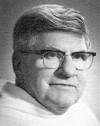 Born in Appleton, Wisconsin, on August 7, 1901, Walter Henry Van Rooy was one of
the ten children of Henry and Johanna Van Rooy, and the twin brother of Ruth M. Van
Rooy. He attended St. Mary's Parochial School and Appleton High School in Appleton.
Following three years of college work at St. Francis Seminary in Milwaukee,
Wisconsin, he entered the Dominican Order at St. Joseph's Priory, Somerset, Ohio,
receiving the habit and the religious name of Daniel on September 25, 1924. A year
and a day later, he professed simple vows at St. Rose Priory in Springfield, Kentucky.
Born in Appleton, Wisconsin, on August 7, 1901, Walter Henry Van Rooy was one of
the ten children of Henry and Johanna Van Rooy, and the twin brother of Ruth M. Van
Rooy. He attended St. Mary's Parochial School and Appleton High School in Appleton.
Following three years of college work at St. Francis Seminary in Milwaukee,
Wisconsin, he entered the Dominican Order at St. Joseph's Priory, Somerset, Ohio,
receiving the habit and the religious name of Daniel on September 25, 1924. A year
and a day later, he professed simple vows at St. Rose Priory in Springfield, Kentucky.
Philosophical studies were taken at the Dominican House of Studies in River Forest, Illinois, and theological courses at the House of Theology in Washington, D.C. His ordination to the priesthood took place on June 15, 1931, at St. Dominic's Church in Washington.
In 1932, he was awarded the Master of Arts degree in English from the Catholic University of America and was then assigned to Fenwick High School where he taught English and religion from 1932 to 1934. For the next two years, he worked as an associate pastor at Blessed Sacrament Priory in Madison, Wisconsin, and studied Gennan literature at the University of Wisconsin. He returned to Fenwick in 1936 and taught Religion, English, Latin, and German there until 1960; during that time, he also served as principal of the high school from 1943 to 1946, and as building fund director from 1946 to 1948.
In 1960, Father Van Rooy was appointed pastor of St. Albert the Great Parish in Minneapolis as well as superior of the Dominican community and served there for three years. From 1964 to 1967, he was Chairman of the Theology Department and taught philosophy and theology at Presentation College in Aberdeen, South Dakota; he also fulfilled the duties of chaplain at the College and at the Motherhouse of the Presentation Sisters. From 1967 to 1976, his teaching career continued on the faculty of Bishop Lynch High School in Dallas, Texas. When ill health forced him into limited service, he remained assigned to Saint Joseph Priory in Dallas until his return to Chicago in 1981, the year of his fiftieth anniversary of ordination to the priesthood.
Father Van Rooy spent the last four years of his life in Appleton, Wisconsin, caring for his aging sisters. On August 10, 1985, he suffered a stroke and thereafter began to fail rapidly. He died a peaceful death on November 10, 1985. Following a funeral Mass at the Priory of St. Dominic and St. Thomas in River Forest, he was buried in the Dominican plot at All Saints Cemetery in Des Plaines, Illinois, on November 13.
FRANCIS XAVIER HYACINTH ROTH
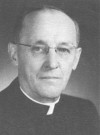 Born on May 21,1899, Francis Xavier Roth was the second of the five children of Josef
and Anna Riss Roth of Passau-Hacklberg, Bavaria, Germany. After his mother died of
pneumonia in 1907, his father remarried and another brother and sister were added to
the Roth Family.
Born on May 21,1899, Francis Xavier Roth was the second of the five children of Josef
and Anna Riss Roth of Passau-Hacklberg, Bavaria, Germany. After his mother died of
pneumonia in 1907, his father remarried and another brother and sister were added to
the Roth Family.
From 1905 to 1914, Francis Roth received his primary education in the public schools of Saldenburg and Schloss Egg. His secondary education was completed at the "Gymnasium" (high school) and the Military Academy in Passau, Bavaria. The next two years were spent at St. Maximilian Seminary in Passau. In 1917, while a member of the National Guard of Griesbach during World War I, he suffered an almost fatal injury which affected his health in later years.
From 1919 to 1923, he attended the Ludwig Universität in Munich. During that same period, he was employed by the Archbishop of Munich, Cardinal Faulhaber, to serve as chauffeur to Eugenio Cardinal Pacelli, Papal Nuncio to Bavaria. In the late 1930's, when Cardinal Pacelli, as Papal Secretary of State, visited the Catholic University of America in Washington, he recognized a young Dominican and stopped his car to greet Brother Francis Roth, a moment which was widely publicized by the press. A short time later, a newly elected pope took the name of Pius XII.
In 1923, Francis Roth departed for the United States and Baltimore where his sister lived. He found work in a restaurant. He regretted that he was getting too old to become a priest but was encouraged by his pastor to apply to the Dominicans. After his ordination he never took a vacation and explained that he had gotten a late start in his ministry and "there was so much work to be done."
In 1926, he began studies at Providence College, and in 1929 applied for admission to the Order. He received the Dominican habit and his religious name of Hyacinth on August 15, 1931, at St. Rose Priory in Springfield, Kentucky. After simple profession on August 16,1932, he went to the Dominican House of Studies in River Forest, Illinois, for philosophical studies; theological studies were taken at St. Joseph Priory, Somerset, Ohio, and the Dominican House of Studies in Washington, D.C., from 1935 to 1939. He was ordained to the priesthood on June 16, 1938.
Having completed his studies, Father Roth was assigned to St. Margaret Parish in Boyce, Louisiana. For the next twenty-three years he served the missions of that district as pastor or associate. During these years he was Diocesan Director of the National Catholic Rural Life Conference and also was active in preparing and broadcasting many religious programs on local radio stations.
From 1962 to 1964, Father Roth was assigned to Amarillo, Texas. Then he was reassigned to Louisiana where he served in the parishes at Boyce and Montgomery until 1972. A classmate who knew him well said, "He was deeply loved by the rural poor for his kindness, his ready smile, his spirit of sacrifice."
Ill health forced Father Roth to retire. After several surgeries, followed by a series of strokes in 1972, he required constant nursing care and became a resident in the Natchitoches Parish Hospital. In 1975, he was moved to Heritage Manor Nursing Horne in Dubuque, Iowa, and remained there until, having contracted pneumonia, he died on December 30, 1985. Following a funeral Mass at the Priory of St. Dominic and St. Thomas in River Forest, he was buried in the Dominican plot at All Saints Cemetery in Des Plaines, Illinois, on January 2, 1986.
THOMAS EDWARD CLEMENT McANDREW
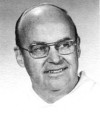 Thomas Edward McAndrew was born on March 16, 1917, in Chicago, Illinois. He was
the oldest of the seven children of John and Esther Maguire McAndrew. He received
his primary education at St. William Grade School, Chicago, and at St. Patrick
Elementary School, Cobalt, Ontario, and then attended Fenwick High School in Oak
Park, Illinois, graduating in 1935. From 1936 to 1941, he pursued a business
curriculum at Loyola University in Chicago.
Thomas Edward McAndrew was born on March 16, 1917, in Chicago, Illinois. He was
the oldest of the seven children of John and Esther Maguire McAndrew. He received
his primary education at St. William Grade School, Chicago, and at St. Patrick
Elementary School, Cobalt, Ontario, and then attended Fenwick High School in Oak
Park, Illinois, graduating in 1935. From 1936 to 1941, he pursued a business
curriculum at Loyola University in Chicago.
On September 24,1941, Thomas McAndrew received the Dominican habit and was given Clement as his religious name at the Dominican House of Studies in River Forest, Illinois. He made his first profession on October 4, 1942, and remained at the Dominican House of Studies in River Forest throughout his philosophical and theological studies. There, on June 4, 1948, he was ordained to the priesthood.
Following the completion of his studies in 1949, he was sent to Ponchatoula, Louisiana, to serve as an associate pastor at St. Joseph Parish. In 1954, he was assigned to St. Pius V Parish in Chicago where he served as associate pastor and co-director of the Shrine of St. Jude Thaddeus until 1959. For the next two years, Father McAndrew became a member of the Dominican Mission Band with headquarters at St. Anthony of Padua Priory in New Orleans.
In 1961, he returned to Chicago; once again he became an associate pastor at St. Pius V Parish and in addition, served as Provincial Treasurer until 1966 when he was appointed pastor of St. Joseph Parish, Ponchatoula, Louisiana. During the next seven years, he ministered not only to his parishioners but also to his confreres as superior for his Dominican brethren and as Dean and member of the Priests' Senate in the Diocese of Baton Rouge.
In 1973, Father McAndrew's final assignment brought him back to Chicago and the Shrine of St. Jude, where he served until mid-November, 1985, when ill health sent him into the hospital for surgery. Preliminary testing indicated that he suffered from anemia and additional testing was followed by surgery for the removal of his spleen. His recovery was complicated by bronchopneurnonia and on January 6,1986, he died at St. Joseph's Hospital. Following funeral services at St. Pius V Church, he was buried in the Dominican plot at All Saints Cemetery in Des Plaines, Illinois.
RINALDO ANGELICO ZARLENGA
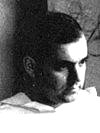 Born in Pietrabbondante (Campobasso), Italy, on April 25, 1919, Rinaldo Zarlenga was
the sixth of nine children. His early education took place in local schools in his
hometown. At the age of ten, Rinaldo was sent to Dominican schools in Gubbio,
Perugia, and Arezzo, and his life as a Dominican was begun. Many years later, he
wrote, "All my intellectual, moral, spiritual education came from the Order. Also my
artistic education." His youngest brother, Vincent Zarlenga, joined him in the Order
several years later.
Born in Pietrabbondante (Campobasso), Italy, on April 25, 1919, Rinaldo Zarlenga was
the sixth of nine children. His early education took place in local schools in his
hometown. At the age of ten, Rinaldo was sent to Dominican schools in Gubbio,
Perugia, and Arezzo, and his life as a Dominican was begun. Many years later, he
wrote, "All my intellectual, moral, spiritual education came from the Order. Also my
artistic education." His youngest brother, Vincent Zarlenga, joined him in the Order
several years later.
In 1935, Rinaldo received the Dominican habit and was given the name, Angelico, as his religious name. On October 17,1936, he made his simple profession in the Order at the Convento San Domenico in Pistoia, Italy. From 1936 to 1943, he studied philosophy and theology at the Pontifical University of St. Thomas Aquinas (Angelicum) in Rome, and achieved the doctorate in theology in 1944. His ordination to the priesthood took place on October 26, 1941 at the Chiesa San Carlo Ai Catinari in Rome.
Because of his talent and love for art, he continued formal training in art in Rome under the well known painter, Orazio Amato. From 1944 to 1947, he attended the Institute "Beato Angelico" for Religious Art and was awarded the Master of Fine Arts degree. During this time, he also studied at the National Academy "San Luca," the world's oldest academy of fine arts where Raphael, Michelangelo, Bemini and other great artists once taught, and "San Giacomo" School of Art. From 1946 to 1948, he also directed the "Corsi Superiori d'Arte" at the Institute "Beato Angelico."
In 1949, Father Zarlenga was sent to the United States to work in the field of religious art; in 1957, he became an American citizen. In addition to his artistic projects, lectures and seminars, he taught philosophy and theology for several years: from 1952 to 1953 at the College of St. Teresa in Winona, Minnesota; from 1953 to 1954 at St. Xavier College in Chicago, Illinois; and from 1954 to 1958 at De Paul University in Chicago.
In 1957, he received permission to establish the Studio Fra Angelico for Religious Art, which he envisioned as a Dominican apostolate to the artistic community of Chicago. In mid-1958, Father Zarlenga dedicated himself on a full-time basis to the art apostolate, lecturing and creating religious works in many art media: wood carving, stained glass, painting, sculpture, mosaics, and others. He became well known among church artists all over the world and maintained studios in Rome and Pietrasanta, Italy, as well as the Studio Fra Angelico at the Priory of St. Dominic and St. Thomas in River Forest, Illinois. His works were shown in exhibits in Chicago, Cincinnati, and Rome.
Over the years, Father Zarlenga completed art works which can be found notably at Fenwick High School in Oak Park; St. Pius V Church, St. Philomena Church, and St. Symphorosa Church in Chicago; St. Attracta Church in Cicero; Divine Savior Church in Norridge, Illinois; Saint Dominic Church in New Orleans, Louisiana; the former Dominican Novitiate in Winona, Minnesota; Riverside Hospital Chapel in Kankakee, Illinois; and Santa Maria Sopra Minerva in Rome. His stained glass window for the Vatican was placed in the apartment of the Pope's theologian.
A diabetic for most of his adult life, in the early 1980's, tests indicated that he was also a victim of cancer. His health declined steadily during the last few years of his life, and he died quietly on February 28, 1986, at the Priory of St. Dominic and St. Thomas. Following a two-day wake at the Priory and a funeral Mass on March 5 at St. Vincent Ferrer Church, River Forest, Illinois, his body was transported to Italy for interment in the family burial plot in his hometown near Rome.
CHRISTOPHER GERALD EDWARD KIESLING
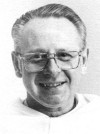 Gerald Edward Kiesling was born in Chicago, Illinois, on August 15, 1925, the son of
Edward Joseph and Florence Marie Fiset Kiesling. His only brother, Curtis James,
preceded him in death at the age of twenty-two. Some time after his baptism at St.
Gregory Church, the family moved to Elmwood Park, Illinois, where the first three
years of his scholarly career were undertaken in John Mills Public School. Gerald
completed his elementary education at Our Lady of Victory School and his secondary
education at Quigley Preparatory Seminary in Chicago. Following a year of college
work at Quigley, he studied philosophy at St. Mary of the Lake Seminary in
Mundelein, Illinois, from 1944 to 1947.
Gerald Edward Kiesling was born in Chicago, Illinois, on August 15, 1925, the son of
Edward Joseph and Florence Marie Fiset Kiesling. His only brother, Curtis James,
preceded him in death at the age of twenty-two. Some time after his baptism at St.
Gregory Church, the family moved to Elmwood Park, Illinois, where the first three
years of his scholarly career were undertaken in John Mills Public School. Gerald
completed his elementary education at Our Lady of Victory School and his secondary
education at Quigley Preparatory Seminary in Chicago. Following a year of college
work at Quigley, he studied philosophy at St. Mary of the Lake Seminary in
Mundelein, Illinois, from 1944 to 1947.
He entered the Dominican Order at the Dominican House of Studies, River Forest, Illinois, where he received the habit and the religious name of Christopher on August 4, 1947. A year and a day later, he professed simple vows in the same Priory, then continued studies there until 1951, at which time he moved to St. Rose Priory in Dubuque, Iowa, to pursue theological studies until 1955. He was awarded the licentiate in philosophy in 1949 and the lectorate of Sacred Theology in 1955. His ordination to the priesthood took place in the St. Rose Priory Chapel in Dubuque, Iowa, on May 27,1954.
Following additional theological studies at the Pontifical University of Saint Thomas Aquinas (the Angelicum) in Rome in 1955 and 1956, he achieved the Licentiate of Sacred Theology degree. In 1960 to 1961, he was awarded the Doctorate of Sacred Theology from the Pontifical Faculty of the Dominican House of Studies in Washington, D.C. During the academic year 1970-1971, he studied at Yale University Divinity School through a research fellowship.
In 1956, Father Kiesling was assigned to the faculty of Aquinas Institute in Dubuque, a position which he held throughout his priestly life; in 1981, he moved to St. Louis with the school to its present location at Saint Louis University. In addition, he taught theology and liturgy courses at Mount Saint Bernard Seminary in Dubuque as well as summer courses at St. Xavier College in Chicago, Illinois; Aquinas College in Grand Rapids, Michigan; Siena Heights College, Adrian, Michigan; and the University of San Francisco in California. From 1969 to 1975, he was Director of the Formation Program for Diocesan Seminarians in Dubuque; from the mid-1960's and into the 1980's, he was involved in ecumenical activities, serving on the Roman Catholic/Presbyterian Reformed Consultation Board and also on the Committee for an Ecumenical Marriage Rite sponsored by the Bishops' Committee on the Liturgy.
Service to the Province of St. Albert the Great included the position of Formation Director for Dominican Students from 1975 to 1981 as well as membership on the Provincial Council, 1977 to 1981; Board of Directors of the St. Jude Apostolate, 1976 to 1979; and the Commission on Social justice, 1984 to 1986. From 1956 to 1976, he was an Associate Editor of Cross and Crown. Upon his appointment as Editor in 1977, the journal was renamed Spirituality Today; he resigned the editorship in 1985 because of ill health.
Throughout his priestly and teaching career, Father Kiesling wrote several books on theological and liturgical subjects. He also produced numerous articles for theological and professional journals, as well as for magazines with a wider audience among the laity.
At the request of the Provincial Chapter of 1985, the Master of the Dominican Order, Father Damian Byrne, bestowed the Master of Sacred Theology degree upon Father Kiesling. The S.T.M. was conferred upon him during a special Liturgy of the Eucharist held at St. Dominic Priory in St. Louis, Missouri, on December 16, 1985.
In 1980, Father Kiesling was found to have cancer of the trachea, and he endured surgery, chemotherapy, and radiation treatments in the following years. The disease became inoperable in 1986. After being hospitalized for several weeks, he died on September 2, 1986. Following a wake at St. Louis Bertrand Priory in St. Louis, Mass was celebrated in St. Francis Xavier College Church at St. Louis University on Thursday, September 4. He was then moved to the Priory of St. Dominic and St. Thomas in River Forest, where another Mass was celebrated on Friday evening, September 5. Interment followed at All Saints Cemetery, Des Plaines, Illinois, on September 6.
In 1947, as a diocesan seminarian, Gerald Kiesling applied to the novitiate explaining that he wished to become a religious "to live a more intense, less distracted spiritual life, to make my priesthood as perfect as possible." And he chose the Dominican Order because "It unites the active with the contemplative life and is devoted to the truth and the intellectual apostolate." As a student, teacher, writer, preacher and spiritual guide, Chris pursued that goal with firm purpose and a fine consistency for thirty-nine years.
ARTHUR FRANCIS CORNELIUS RICHMEIER
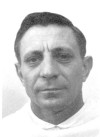 Arthur Francis Richmeier was born in St. Peter, Kansas, on January 3,1928, the third
oldest of the ten children of Wendeline and Mary BoxIer Richmeier. He attended St.
Anthony's School, St. Peter, Kansas, and Holcomb Consolidated School, Holcomb,
Kansas, from 1934 to 1942. For the next nine years he worked on the family farm.
Arthur Francis Richmeier was born in St. Peter, Kansas, on January 3,1928, the third
oldest of the ten children of Wendeline and Mary BoxIer Richmeier. He attended St.
Anthony's School, St. Peter, Kansas, and Holcomb Consolidated School, Holcomb,
Kansas, from 1934 to 1942. For the next nine years he worked on the family farm.
From 1951 to 1954, Arthur served in the United States Armored Infantry, with over a year's service in Germany. At the time of his honorable discharge, he held the rank of Corporal.
Following his return to civilian life, he became employed as a maintenance man at St. Catherine's Hospital, Garden City, Kansas, one of the apostolates of the Dominican Sisters of Great Bend. When he decided to enter religious life, the Administrator of the Hospital wrote:
Mr. Richmeier worked at St. Catherine Hospital for approximately five years. During that time we could not ask for a more loyal worker and friend. He was always available, regardless of the time of day or night, to perform whatever task the Sisters might require. He worked very hard, was never lazy, and never shirked any of his duties whether difficult or menial.This testimonial was true of Arthur throughout his entire life in the Order.It is practically impossible to replace an employee of Mr. Richmeier's caliber, but we are very happy for him. We recommend him to you as a man we know to be hard-working, devoted and loyal.
Arthur entered the Dominican Order on June 1, 1959, receiving the habit and religious name of Cornelius, at the Dominican House of Studies in River Forest, Illinois. A year and a day later, he professed simple vows there.
Brother Arthur spent all his years in the Order at the Priory in River Forest, engaged primarily in auto maintenance for both the Priory and Fenwick High School Athletic Department, and the care of the lawns and roads on the Priory grounds. He also assisted with other repairs and maintenance as time allowed, as well as with the maintenance work at Dominican Camp (later renamed Camp Tamarack) in Menominee, Michigan.
In March, 1986, Brother Arthur was found to have cancer of the esophagus. In spite of treatment, the disease could not be controlled and he failed rapidly and died a peaceful death on December 7, 1986. Following a funeral Mass at the Priory of St. Dominic and St. Thomas in River Forest on December 9, he was buried at his request in the family plot of St. Mary's Cemetery at Garden City, Kansas.
JOSEPH JOACHIM HAGAN
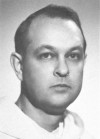 Joseph Peake Hagan was born in New Haven, Kentucky, on February 12, 1915, the
youngest of the three sons of John and Mary Peake Hagan. He attended St. Louis
Bertrand Grammar School and spent one year at Male High School, both in Louisville,
Kentucky. He then completed his high school education at Aquinas High in Columbus,
Ohio, followed by two years at Providence College, Providence, Rhode Island.
Joseph Peake Hagan was born in New Haven, Kentucky, on February 12, 1915, the
youngest of the three sons of John and Mary Peake Hagan. He attended St. Louis
Bertrand Grammar School and spent one year at Male High School, both in Louisville,
Kentucky. He then completed his high school education at Aquinas High in Columbus,
Ohio, followed by two years at Providence College, Providence, Rhode Island.
On August 15, 1935, he entered the Dominican Order at St. Rose Priory in Springfield, Kentucky, receiving the habit and the religious name of Joachim. A year and a day later, he professed simple vows there, then went to the Dominican House of Studies in River Forest, Illinois, for philosophical and theological studies. His ordination to the priesthood took place on June 11, 1942.
Following the completion of his theological studies in 1943, he began his ministry as an associate pastor at St. Albert the Great Parish. In August of 1945 he was assigned as chaplain at Trinity High School and professor at the House of Studies in River Forest as well as professor of philosophy at De Paul University in Chicago. The next year he was sent to Rome to continue studies in canon law at the Angelicum. He was awarded the J.C.D. degree in 1949.
Upon his return to the States, he served as professor at the Dominican House of Studies in River Forest and at Mundelein College, Chicago, as well as magister spiritus sacerdotum and Defensor Vinculi in the Archdiocesan Tribunal. From 1951 to 1965, he lived at St. Rose Priory in Dubuque, Iowa, and served as professor of canon law and magister spiritus at Aquinas Institute and as Defensor Vinculi in the Dubuque Diocesan Tribunal. In 1961, at the request of Archbishop Binz of Dubuque, he was awarded the S.T.M. by the Master of the Order, Father Michael Browne, O.P.
Following a heart attack in 1965, his doctor advised him to end his dual career in teaching and Tribunal work. During his convalescence, from 1965 to 1967, he updated his Scripture and theology, and then resumed teaching duties at Aquinas Institute. Because of the need to care for an elderly aunt, Father Hagan moved to Louisville in 1969, and worked as an associate pastor, substituting for staff members at St. Louis Bertrand and Blessed Sacrament Parishes as well as for hospital chaplains there. In addition, he added an apostolate of visiting several shutins a day throughout the city.
In 1980, following his aunt's death, Father Hagan moved to the Priory of St. Dominic and St. Thomas in River Forest, Illinois. For the next several years he assisted in parish ministry on a limited basis. After a short illness, he died on December 29,1986. A Mass of the Resurrection was celebrated on December 31, 1986, followed by burial in the St. Rose Priory Cemetery at Springfield, Kentucky.
WILLIAM FRANCIS RAPHAEL BURKE
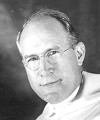 Born in Louisville, Kentucky, on June 3, 1888, William Francis Burke was one of the
six children of Michael Joseph and Mary Doyle Burke. His early education was
undertaken in Louisville at Cathedral Grade School from 1894 to 1896, St. Patrick
Grade School from 1896 to 1898, and Public School from 1898 to 1902. After
completing grammar school, he spent seven years as a salesman for J.M. Robinson
Norton Company in Louisville. From 1910 to 1913, he completed his secondary
education at St. Patrick High School in Columbus, Ohio, the Apostolic School for the
Province of St. Joseph which changed its name to Aquinas College in 1912. Following
a year of studies at St. Mary's College in St. Mary's, Kentucky, he entered the
Dominican Order at St. Joseph Priory in Somerset, Ohio, receiving the habit and the
religious name of Raphael on October 25, 1914. A year and a day later, he professed
simple vows at the same priory,
Born in Louisville, Kentucky, on June 3, 1888, William Francis Burke was one of the
six children of Michael Joseph and Mary Doyle Burke. His early education was
undertaken in Louisville at Cathedral Grade School from 1894 to 1896, St. Patrick
Grade School from 1896 to 1898, and Public School from 1898 to 1902. After
completing grammar school, he spent seven years as a salesman for J.M. Robinson
Norton Company in Louisville. From 1910 to 1913, he completed his secondary
education at St. Patrick High School in Columbus, Ohio, the Apostolic School for the
Province of St. Joseph which changed its name to Aquinas College in 1912. Following
a year of studies at St. Mary's College in St. Mary's, Kentucky, he entered the
Dominican Order at St. Joseph Priory in Somerset, Ohio, receiving the habit and the
religious name of Raphael on October 25, 1914. A year and a day later, he professed
simple vows at the same priory,
Philosophical studies followed from 1915 through 1917, and theological courses from 1918 through 1921 at the Dominican House of Studies in Washington, D.C. On June 12, 1921, William Raphael Burke was ordained to the priesthood at St. Dominic's Church in Washington. Later in his life, he wrote:
Perhaps the fondest recollections are of student days in Somerset, Ohio. Wandering over fields and roads, and meeting a Master General of the Order under rather informal conditions stand out at the beginning of my Dominican career. Student days in Washington bringback vivid memories. The priests who formed the faculty were superb men of God. I recall attending some of the sessions of Congress at the time of our entering the first World War, which made quite an impression on the memory. Being present for the laying of the cornerstone of the Shrine at the Catholic University is a memory not easily erased.Father Burke's first assignment was to the Eastern Mission Band, with residence at St. Dominic Priory in Washington; he was engaged in full-time preaching from 1922 to 1929. In June, 1929, he was elected Prior of St. Dominic Priory. When a fire destroyed the interior and roof of Saint Dominic's, he was responsible for planning the reconstruction of the building. He also continued his preaching ministry on a part-time basis while serving as Prior. On March 8, 1934, the degree of Preacher General was conferred on him at the House of Studies in River Forest.
In June, 1933, Father Burke was installed as Vicar Provincial of the Vicariate of St. Albert the Great with residence at the Dominican House of Studies in River Forest, Illinois. Toward the end of his second term as Vicar, on December 22, 1939, the Vicariate became the Province of Saint Albert the Great and he chose to affiliate with the new Province.
In 1940, he was assigned to the Southwestern Mission Band, with residence at Holy Rosary Priory in Houston, Texas. From 1942 to 1948, he served as Pastor of St. Albert the Great Parish in Minneapolis, Minnesota. During this time, he planned and began the construction of the new church and priory, but because his second term as Pastor expired, the project was completed under the supervision of his successor, Father John Nugent.
Father Burke was then assigned to the Western Mission Band with residence in St. Dominic Rectory, Denver, Colorado. Three years later, in 1950, he assumed the duties of chaplain at St. Dominic Villa, Dubuque, Iowa, a position he held until 1967. Because of age and ill health, he was placed on limited service, living at St. Rose Priory in Dubuque, but continued to serve as confessor for the sisters at St. Dominic Villa. For several months in 1971, he served as an assistant pastor at St. Margaret Parish, Boyce, Louisiana, but ill health forced him into limited service once again. From 1971 to 1973, he lived at St. Albert the Great Priory in Irving, Texas. In 1973, Father Burke once again moved into active service as part-time chaplain at the Motherhouse of the Presentation Sisters in Aberdeen, South Dakota, serving there until 1981 despite a number of strokes and complications.
At the age of ninety-three and following another stroke, Father Burke asked that he be allowed to spend his remaining months closer to his Dominican brethren and was thereupon transferred to the Oak Park Convalescent and Geriatric Center in Oak Park, Illinois, about a mile from the Priory of St. Dominic and St. Thomas in River Forest. There he proceeded to develop a ministry as resident chaplain, celebrating Mass and extending comfort and friendship to his fellow residents and the staff. When interviewed by a reporter for a local newspaper at the age of ninety-six, Father Burke said, "It has been the joy of my life that the Lord has let me live so I might in my old age still be able to serve him while serving his good old folks, his good old people."
In late December, 1986, Father Burke contracted a severe cold which developed into pneumonia. Following a short period of hospitalization, he died on January 21, 1987. A Mass of the Resurrection was celebrated at the Priory of St. Dominic and St. Thomas in River Forest, after which he was buried in the Dominican plot at All Saints Cemetery, Des Plaines, Illinois, on January 24, 1987.
ALBERT AUGUSTINE BERTRAND NIESER
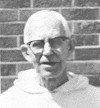 Albert Bricker was born April 1, 1906, in Barberton, Ohio. He was baptized two weeks
later in St. Augustine's Church. Augustine became his second name. His parents were
William Bricker and Florence Pearl Weaver Bricker. After his mother died, he was
given for adoption, at the age of three, to Karl and Mary Nieser. The Niesers had
immigrated from Saarbrucken, Germany; Karl was a pressman in a rubber factory.
Much later in life Albert was surprised to meet a natural sister whom he did not know
he had.
Albert Bricker was born April 1, 1906, in Barberton, Ohio. He was baptized two weeks
later in St. Augustine's Church. Augustine became his second name. His parents were
William Bricker and Florence Pearl Weaver Bricker. After his mother died, he was
given for adoption, at the age of three, to Karl and Mary Nieser. The Niesers had
immigrated from Saarbrucken, Germany; Karl was a pressman in a rubber factory.
Much later in life Albert was surprised to meet a natural sister whom he did not know
he had.
Albert Nieser attended St. Augustine's Parish School and Sacred Heart Academy in Akron. Eventually he graduated from Aquinas High School in Columbus, Ohio, at the age of twenty-three. He attended Providence College, Providence, Rhode Island, until the summer of 1931, whenhe entered the Dominican novitiate in Springfield, Kentucky. After his first profession he studied at the Dominican House of Studies in River Forest, Illinois. He made his solemn profession of vows in 1935. He studied theology in Somerset, Ohio, and Washington, D.C., where he was ordained to the priesthood on June 16, 1938.
His religious name was Bertrand, but he became best known as "Slug." He claimed that he earned the name by his batting average, but it may have derived from his love for cops, robbers, and mystery stories (a copy of a literary work from his college days, The Showdown, or the Disappearance of Mr. Stern, is in the Provincial Archives).
Father Nieser was assigned to teach history at Fenwick High School in Oak Park, Illinois. He continued his own studies and completed a Master's degree at Catholic University in 1942, having written a thesis on The Status of Research on the Rule of St. Augustine. He then continued studies at Loyola University, Chicago, while teaching at Fenwick until 1949. His vision was deteriorating seriously, to the degree that his physician insisted that he quit his studies. Efforts to stop him, by doctors and Dominicans, failed. One of his contemporaries compared him to V.F. O'Daniel in saying that "what Slug lacked in brilliance he made up for by monumental perseverance and industry."
In 1949-1950, Father Nieser was permitted to travel to various archives in Texas, California, Mexico, Rome, and Spain. He collected thousands of microfilms and photos of manuscripts dealing with the Dominican missions in Baja California. Seeking various perrnissions at every step of the way, he wrote to the Provincial, Father Hughes, "These Spaniards certainly scattered things all over creation." He expressed a hope for a teaching position at Loyola or De Paul, or "at Fenwick or at whatever you put me," hoping at the same time to complete his translations and a thesis in a single year. He remained assigned and teaching at Fenwick and continued his studies at Loyola for two more years. In 1960, his dogged industry was rewarded by a Ph.D. His dissertation is entitled The Dominican Mission Foundations in Baja California, 1769 - 1822.
From 1952 to 1957, Father Nieser served as chaplain and instructor for the Dominican Sisters at Racine, Wisconsin; from 1957 to 1960 at Sinsinawa, living and working with another historian, Bernard Walker; and from 1960 to 1965 at the Dominican Monastery of the Perpetual Rosary in Milwaukee. In 1965, he was sent to Aberdeen, South Dakota, first as chaplain in St. Luke's Hospital, and then in the infirmary of the Presentation Sisters. On one occasion Father Nieser was roused from a siesta because a patient was dying. Under the circumstances it took him a little time to get to the room. When he arrived and was told that the woman had died, he replied, "Oh well, we've all got to go some time. It happens to the best of us." This was his calm acceptance of human reality, spoken without violating his unfailing gentleness and kindness.
Slug's time to leave the active ministry came, much to his chagrin, in 1980. After some time in an extended care facility near Chicago, he moved to St. Pius V Priory. As he became increasingly senile and needed constant care, he was moved to the Little Sisters of the Poor Center for the Aging. When all neurological activity was "essentially negative," his body persisted calmly in good health. But "finally he died," on February 25,1987, at the age of eighty. He was buried in the Dominican plot at All Saints Cemetery, Des Plaines, Illinois, after the funeral Mass at Saint Pius on February 27. Father James Brendan Kelly, who had been Father Nieser's student at Fenwick and then had looked after him in his final years, preached the eulogy.
Father Nieser had always been a quiet, unpretentious man, and his final years were spent in total silence. He had had little family from the age of three, and in the end no survivors. It seemed ironic that the printer mistook the order and delivered 10,000 memorial cards for Slug.
COLUMBA PATRICK THOMAS JOSEPH McGARRY
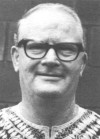 Patrick McGarry was born on February 8,1922, in Sheegora, Boyle, County
Roscommon, Ireland, which is located almost exactly in the geographical center of the
Republic of Ireland. He was the third child of seven: six sons and one daughter, of John
and Bridget Walsh McGarry. He was born in a farmhouse that was built from the local
stones that litter the Irish countryside, on property that his father and grandfather had
tilled as their vocation and sole source of income.
Patrick McGarry was born on February 8,1922, in Sheegora, Boyle, County
Roscommon, Ireland, which is located almost exactly in the geographical center of the
Republic of Ireland. He was the third child of seven: six sons and one daughter, of John
and Bridget Walsh McGarry. He was born in a farmhouse that was built from the local
stones that litter the Irish countryside, on property that his father and grandfather had
tilled as their vocation and sole source of income.
Patrick McGarry attended Deerpark National School in Boyle for his primary and secondary education. That was followed by two years at Saint Kieran's College in Bray, County Wicklow, a teacher-training college, where he developed an interest in and studied Gaelic. In September, 1942, he began teaching in a government primary school, but his desire for adventure and new horizons, which was to be one of his outstanding traits during his life, began to dominate his thinking. During a long school holiday in 1943, he travelled to Dublin to see about the possibility of emigrating to the United States where several of his relatives were settled and prospering. Because of the war, however, no one was being allowed to emigrate. But the officials at the American Embassy agreed to place his name on a waiting list of Irish citizens hoping to go to America, and he returned to his teaching job in Boyle. Early in 1946, he was informed that he could emigrate and so he was with the first group of Irish citizens to imigrate to America after the end of World War II.
In the United States, Patrick was received by an uncle and his wife in NewJersey. Within a few days he had found a clerical job and was soon able to rent his own place and purchase a used Chevrolet car. He was granted American citizenship in May, 1953.
In 1952, he had joined the Brothers of the Good Shepherd in Albuquerque, New Mexico, but departed from this community because he felt he was not well prepared for their religious life and ministry. He again found work, and during vacations travelled to various cities in an effort to learn more about his new country. In August, 1954, his annual journey took him to Minneapolis, where he happened to attend Sunday Mass in a Dominican parish and heard a sermon by Father Vincent Kienberger. After Mass, he talked with this Dominican priest and, through subsequent correspondence with him and contact with other Dominicans, was able to discern that he had a vocation to the Dominican Order as a cooperator brother. He entered the Order, receiving the habit and his religious name of Columba, on March 24, 1955.
Following his novitiate at the Dominican House of Studies in River Forest, Illinois, and his first profession there on March 25, 1956, Brother Columba was assigned to general maintenance and office work at St. Anthony of Padua Priory in New Orleans, Louisiana, from 1956 to 1959; at St. Rose Priory in Dubuque, Iowa, from 1959 to 1962; at Fenwick High School in Oak Park, Illinois, from 1962 to 1964; and as sacristan at Holy Rosary Priory and Parish, Minneapolis, Minnesota, from 1964 to 1968.
When he expressed interest in serving the missions, Brother Columba was sent to Nigeria, arriving in Gusau in September, 1968. His first seven years in Nigeria centered around Gusau. His former teaching experience made him an excellent catechist and religious doctrine teacher, while his accounting ability was put to good use in the position of business manager of the parish and community. In 1969, he also assisted in reopening the parish in Katsina, which had been closed since 1966 because of the civil war.
In 1976, Brother Columba enrolled in a continuing education course in Lagos, the "T.I.M.E. Project," which qualified him to teach religious subjects in secondary schools in Nigeria. From 1977 to 1980, he taught in several schools in Sokoto City.
In 1980, Brother was assigned to the Dominican Priory in lbadan and as economic administrator of the community. He also developed a course on the history of the Dominican Order which he taught to most of the Dominican brothers now in formation. Columba made a significant contribution to the young Vice-Province of Nigeria by teaching the Constitutions to the students and by helping them to improve their knowledge and use of English, since English is generally their second or third language. In 1986, he was appointed Assistant Director of Novices. In keeping with his strong devotion to our Lady, he published a small booklet, entitled "Meditations on the Rosary," in 1982, with original drawings by one of the Nigerian students.
Columba's infrequent visits to his homeland in Ireland were to see his aged father and his brothers (his sister married and moved to England), to repaint or whitewash the cottage where he had grown up, and to arrange for a "station" Mass at the homestead.
On March 2, 1988, while travelling from Ibadan to Yaba, Brother Columba was fatally injured in a tragic automobile accident when the student who was driving fell asleep at the wheel. He was highly honored by being given an African wake service, and two Masses of the Resurrection, one celebrated by Bishop Job in Ibadan, and the other by Archbishop Okogie of Lagos, with over fifty Dominicans in attendance. He was buried in Atan Cemetery, near St. Dominic's Church in Yaba, Lagos State, on March 9, 1988.
In the words of a Nigerian saying which caught Brother Colunba's fancy shortly after he began working at Katsina, "he was a wonderful Somebody."
WILLARD WILLIAM PATRICK RONEY
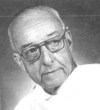 Born in Sioux Falls, South Dakota, on June 12,1909, Willard William Roney was one
of the six children of William and Celia Rose McDonald Roney. His entire education
was taken "from first to last under Dominicans": elementary and secondary education
with the Sinsinawa Dominican Sisters at Cathedral Grade and High Schools in Sioux
Falls, followed by two years at Providence College in Providence, Rhode Island.
Born in Sioux Falls, South Dakota, on June 12,1909, Willard William Roney was one
of the six children of William and Celia Rose McDonald Roney. His entire education
was taken "from first to last under Dominicans": elementary and secondary education
with the Sinsinawa Dominican Sisters at Cathedral Grade and High Schools in Sioux
Falls, followed by two years at Providence College in Providence, Rhode Island.
Willard Roney entered the Dominican Order on August 4,1930, and received the habit and religious name of Patrick on August 15,1930, at St. Rose Priory in Springfield, Kentucky. Following the novitiate and first profession on August 16, 1931, Brother Patrick moved to the Dominican House of Studies, River Forest, Illinois, to study philosophy, achieving a bachelor's degree in 1934. His study of theology was then undertaken at St. Joseph Priory in Somerset, Ohio, and the Dominican House of Studies in Washington, D.C. On June 11, 1937, he was ordained to the priesthood at St. Dominic's Church in Washington and then continued theological studies, as well as special courses in Gregorian chant at the Catholic University (1937 to 1938), public speaking at the Curry School of Expression in Boston, Massachusetts (summer, 1938), and the Preacher's Institute at Catholic University (1941).
Father Roney was assigned to teach homiletics and chant at St. Joseph Priory in Somerset, 1938 to 1939, and at the Dominican House of Studies in River Forest, 1939 to 1940. From 1940 to 1948, he was a member of the Northwest Mission Band, which was based at Holy Rosary Priory in Minneapolis. This was followed by another teaching assignment of homiletics and chant at the House of Studies, along with the duties of Assistant Student Master from 1949 to 1951, at which time he was reassigned to St. Rose Priory in Dubuque, Iowa, serving there in the same capacities until 1954.
The challenges of being a pastor filled the next eight years of his life, first at St. Chrysostom Church in Canton, South Dakota, then at Saint Dominic Church in Denver, Colorado. After three years of service as an associate pastor at St. Joseph Church in Ponchatoula, Louisiana, and then at Holy Rosary Parish in Minneapolis, he requested permission to return to South Dakota so that he could help care for his sister who was bedridden. He was again assigned to St. Chrysostom Church in Canton in 1966. During his term as pastor there, he supervized the construction of a new church and parish center, and in 1972, the name of the parish was changed to St. Dominic.
In 1975, Father Roney was assigned to St. Dominic Priory in Denver (his sister had died in 1972, and he was in ill health), where he remained on limited service until the time of his death. He died on March 5,1988, while undergoing treatment for cancer. Following a funeral Mass at Saint Dominic Church in Denver on March 9, he was buried in the Dominican plot at Mount Olivet Cemetery in Denver, Colorado.
RICHARD EDMUND BUTLER
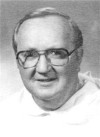 Edmund Butler was born on December 14, 1918, at Salem, Massachusetts, one of the
six children of Joseph and Clara Sylvester Butler. His elementary education was taken
at Pickering School in Salem, and his high school years were spent at St. John's
Preparatory School in Danvers, Massachusetts, from which he graduated in 1937. He
then attended Notre Dame University, 1938 to 1940, and Catholic University of
America, 1940 to 1942, and received a B.A. in English.
Edmund Butler was born on December 14, 1918, at Salem, Massachusetts, one of the
six children of Joseph and Clara Sylvester Butler. His elementary education was taken
at Pickering School in Salem, and his high school years were spent at St. John's
Preparatory School in Danvers, Massachusetts, from which he graduated in 1937. He
then attended Notre Dame University, 1938 to 1940, and Catholic University of
America, 1940 to 1942, and received a B.A. in English.
He entered the Dominican Order at the Dominican House of Studies in River Forest, Illinois, where he received the habit and his religious name of Richard on June 24, 1942. A year and a day later, he made first profession at River Forest, then continued philosophical and theological studies there from 1943 to 1950. The Faculty conferred a master's degree in philosophy in 1946 and a lectorate in theology in 1950. His ordination to the priesthood took place on June 7,1949. Following completion of the
theological program, he was sent to the Pontifical University of Saint Thomas Aquinas (the Angelicum) in Rome for two years and received the doctorate in philosophy.
Father Butlers ministerial years were devoted to the youth of America in campus ministry and teaching: from 1952 to 1953, Instructor at Loras College and Director of Aspirants to the Order in Dubuque, Iowa; from 1953 to 1962 at Aquinas Newman Center in Albuquerque, New Mexico; from 1962 to 1964, National Chaplain of the Newman Apostolate, with headquarters in Chicago; from 1964 to 1968, Provincial Director of the Newman Apostolate, while living at St. Pius V Priory, Chicago, Illinois; from 1968 to 1974 at St. Thomas More Newman Center in Tucson, Arizona; and in 1975, while on sabbatical, teaching in the "Semester Abroad" program of the University of Dallas in Rome. In addition to his campus ministry work in Tucson, Father Butler became the chaplain-director of Los Changuitos Feos de Tucson, a well-known Mexican mariachi band of young men between the ages of thirteen and seventeen, and travelled with them on tour throughout the United States and Mexico.
In 1965, Father Butler was appointed Consultor to the Vatican's Secretariat for Unbelievers. He later served as Secretary to the American Bishops' Commission on Unbelief as well as on the Board of Fellows for the Interpreter's House in North Carolina, a Methodist ecumenical movement. He received numerous awards, among them: the Cardinal Cushing Priest Alumnus Award from St. John's Preparatory School in Danvers, Massachusetts; the Notre Dame Man of the Year designation, a New Mexico Alumni Award, and the Ronald Knox Literary Award of the National Newman Chaplains' Association.
Following his sabbatical in Rome in 1974-1975, and given his ill health, he returned to the States to reside at St. Dominic-St. Thomas Priory in River Forest. He was appointed chaplain and theology teacher at Fenwick High School, directed retreats for religious, and preached for various programs offered at the Priory.
Realizing the need for good theology textbooks, in 1976 he asked for permission to use The Priory Press corporation to revise and republish "The Challenge of Christ" series originally prepared and published by Dominicans in the late 1960's. As general editor of the new series, he worked with other Dominicans and members of the Fenwick faculty to prepare the set of theology textbooks for high school use.
Throughout his lifetime, Father Butler lectured at over forty American colleges and universities and contributed articles to twenty magazines, such as Commonweal, America, The Critic, and U.S. Catholic. He also wrote six books, two of them on the ideas of George Santayana, whom he had known during the last two years of the Harvard philosopher's life. His final volume, Witness to Change. A Cultural Memoir, was written from an autobiographical perspective, reflecting upon the dramatic cultural changes he had witnessed over five decades, 1925 to 1975, and offering a critical analysis of both the societal and ecclesiastical developments during that period.
In early March of 1988, while on a visit to his family in Massachusetts, Father Butler suffered cardiac arrest. He died on March 18. Following a Mass of the Resurrection in Peabody, Massachusetts, on March 21, he was brought back to the Priory of St. Dominic and St. Thomas in River Forest, Illinois. His funeral Mass was celebrated on March 23, and he was buried in the Dominican plot at All Saints Cemetery in Des Plaines, Illinois.
THOMAS DONALD DAMIAN SMITH
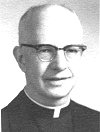 Born on February 2, 1914, in Chicago, Illinois, Thomas Donald Smith was one of the
two sons of Thomas and Johanna Crowley Smith. His primary education was taken at
Our Lady of the Angels School, Chicago; St. Luke's Grammar School, River Forest; St.
Bernardine's School, Forest Park, and St. James School, Maywood, Illinois. Following
a year of high school studies at St. Philip's in Chicago, he completed his secondary
education at Fenwick High School in Oak Park , Illinois, graduating in 1932. He then
attended Providence College, Providence, Rhode Island, for the next two years.
Born on February 2, 1914, in Chicago, Illinois, Thomas Donald Smith was one of the
two sons of Thomas and Johanna Crowley Smith. His primary education was taken at
Our Lady of the Angels School, Chicago; St. Luke's Grammar School, River Forest; St.
Bernardine's School, Forest Park, and St. James School, Maywood, Illinois. Following
a year of high school studies at St. Philip's in Chicago, he completed his secondary
education at Fenwick High School in Oak Park , Illinois, graduating in 1932. He then
attended Providence College, Providence, Rhode Island, for the next two years.
On August 15, 1934, Thomas Smith received the Dominican habit and the religious name of Damian at St. Rose Priory in Springfield, Kentucky. After his novitiate, he made simple profession thereon August 16, 1935. Brother Damian moved to the Dominican House of Studies in River Forest, Illinois, for his philosophical studies and one year of theological studies, receiving a B.A. in June, 1938. He continued theological studies at St. Joseph's Priory, Somerset, Ohio, and then returned to River Forest for the remainder of his pre-ordination studies. He was ordained in the House of Studies chapel at River Forest by Samuel Cardinal Stritch on June 7,1941.
Father Smith's first assignment was to the faculty of Fenwick High School in Oak Park, Illinois, where he taught English. For the next three years, he also attended De Paul University and received a master's degree in English in 1945.
During his tenure at Fenwick, from 1942 to 1968, he also served as director of cooperator brothers for three years, as editor of the Dominican Bulletin for eleven years, as editor of the Dominican Educational Bulletin for three years, and as a member of the Executive Board of the Dominican Educational Association from 1964 to 1968.
He was then assigned as an associate pastor at Holy Rosary Parish, Minneapolis, and also served as procurator to the community there. In 1974, he moved to St. Dominic's Villa, Dubuque, Iowa, where he served as chaplain until 1981, when he accepted a chaplaincy at St. Elizabeth Hospital in Beaumont, Texas.
In early March of 1988, Father Smith was diagnosed as having acute leukemia, and a two-week period of chemotherapy was prescribed in the hope of arresting the disease. On April 7, following the celebration of Mass and the singing of the "Salve" in his hospital room, he died peacefully in his sleep. A wake service was held at St. Elizabeth Hospital in Beaumont on April 8; Mass of the Resurrection was celebrated at St. Ann Church, Beaumont, on April 9; and then he was moved to the Priory of St. Dominic and St. Thomas in River Forest, Illinois. Following a wake and Mass at the Priory on April 11, 1988, he was buried in the Dominican plot at All Saints Cemetery in Des Plaines, Illinois.
FREDERICK EUGENE KLUEG
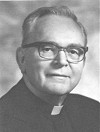 Frederick Klueg was born on May 1, 1915, in Columbus, Ohio, the second of the five
children of Fred and Mary Rose Herbert Klueg. He attended Holy Rosary and St.
Aloysius Grammar Schools and Aquinas High School in Columbus, then studied at
Providence College, Providence, Rhode Island, from 1933 to 1935.
Frederick Klueg was born on May 1, 1915, in Columbus, Ohio, the second of the five
children of Fred and Mary Rose Herbert Klueg. He attended Holy Rosary and St.
Aloysius Grammar Schools and Aquinas High School in Columbus, then studied at
Providence College, Providence, Rhode Island, from 1933 to 1935.
On August 4, 1935, he received the Dominican habit and the religious name of Eugene at St. Rose Priory, Springfield, Kentucky, and made simple profession there on August 5, 1936. Philosophical and theological studies were taken at the Dominican House of Studies in River Forest, Illinois, from 1936 to 1943. He was ordained in River Forest on June 11, 1942, by Bishop Bernard Shiel of Chicago.
In addition to a B.A. in philosophy (1939) and an M.A. in theology (1943), received at the Dominican House of Studies, Father Kjueg obtained a B.S.S.B. in library science (1945) from Rosary College Library School during his first assignment as chaplain and professor at Rosary College, River Forest, Illinois. From 1946 to 1949, he taught philosophy at De Paul University and religion at St. Xavier College in Chicago, Illinois. During this time he served as librarian at the House of Studies in River Forest as well. In 1949, he was sent to the Angelicum in Rome to continue theological studies and received the S.T.D. in moral theology in 1951. Upon his return to the United States in 1951, Father Klueg was assigned to Saint Rose Priory in Dubuque, Iowa, and served as professor of moral and pastoral theology at Aquinas Institute of Theology and at Mount St. Bernard Seminary, as well as librarian at Aquinas Institute, until 1967, when he accepted a position as professor of theology at the University of Dallas, Irving, Texas, for one year.
Because of ill health, he was advised to go into a ministry that was less strenuous than teaching, and so he served as a hospital chaplain for several years, first as a member of the Catholic Chaplain Corps at the Medical Center in Houston, Texas, from 1968 to 1973; then at Southeastern Louisiana State Hospital in Mandeville, Louisiana, from 1974 to 1975. From 1976 to 1980, he served as chaplain to the Dominican Sisters at Rosaryville, Louisiana, as well as acting pastor for the Bedico Mission nearby. During 1981 and 1982, he assisted as a substitute in pastoral supply work in various parishes: St. Bernard, Dallas, Texas; Good Shepherd, Garland, Texas; Holy Rosary, Hahnville, Louisiana; and Saint Louis, King of France in Metairie, Louisiana, where he also served as chaplain at Lakeside Hospital. From 1983 to 1984, he was associate pastor at the Cathedral of St. Raphael in Dubuque, Iowa.
Following congestive heart failure in 1984 and an increasingly severe diabetic condition, Father Klueg was moved to the Priory of St. Dominic and St. Thomas in River Forest, where he remained on limited service until his death on April 18,1988. Following Mass at the Priory on April 20,1988, he was buried in the Dominican plot at All Saints Cemetery in Des Plaines, Illinois.
JOHN FRANCIS HENRY McDONNELL
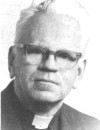 Henry McDonnell was born on October 10, 1915, in Providence, Rhode Island, the
second of the three children of John and Rose Anna Gallagher McDonnell. He was
educated in Providence at St. Mary's Academy of the Visitation from 1921 to 1929, La
Salle Academy from 1929 to 1933, and Providence College from 1933 to 1937.
Henry McDonnell was born on October 10, 1915, in Providence, Rhode Island, the
second of the three children of John and Rose Anna Gallagher McDonnell. He was
educated in Providence at St. Mary's Academy of the Visitation from 1921 to 1929, La
Salle Academy from 1929 to 1933, and Providence College from 1933 to 1937.
On August 15, 1937, Henry McDonnell received the Dominican habit and his religious name of John Francis at St. Rose Priory in Springfield, Kentucky, and began his novitiate year. First profession was made there on August 16,1938. When the Province of St. Albert the Great was established in 1939, he became affiliated to the new Province. His philosophical and theological studies were undertaken at the Dominican House of Studies in River Forest, Illinois, and he was ordained to the priesthood there on June 8, 1944. During the academic year, 1945 to 1946, he was a student at Catholic University in Washington, D.C. His next two years of study were spent at the École Biblique in Jerusalem.
Upon his return to the United States, Father "Chum" McDonnell assumed the positions of Professor of Sacred Scripture at the Dominican House of Studies and Professor of Theology at Rosary College in River Forest, Illinois. After two years, he was assigned to St. Rose Priory and Aquinas Institute in Dubuque, Iowa, where he was Professor of Scripture from 1951 to 1974. In the Fall of 1974, he became a Professor of Scripture at the Pontifical University of St. Thomas (the Angelicum) in Rome, Italy, a position he held until the timeof his death on May 11, 1988.
Several days before his death, Father McDonnell mentioned to one of his brothers that he felt very tired, but this was considered to be due to the heat. On May 10, he suffered a heart attack and was taken to a hospital where, in spite of treatment, he died on the morning of May 11. The Master of the Order presided at a Solemn Funeral Mass on May 13, with more than fifty concelebrants and four hundred students in attendance. Father Alfred Wilder (Southern Province), Prior at the Angelicum residence, gave the homily. Shortly after the ceremony, Father McDonnell's body was moved to Providence, Rhode Island, where a funeral Mass was celebrated on May 17 in the St. Thomas Aquinas Priory Chapel at Providence College. He was buried in St. Francis Cemetery at Pawtucket, Rhode Island.
GERARD EUGENE HALLORAN
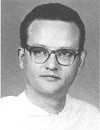 Eugene Halloran was born on August 6, 1937, in Oak Park, Illinois, one of the four
children of William Daniel and Agnes Margaret Higgins Halloran. He attended St.
Luke's Grammar School in River Forest from 1943 to 1945, and completed his
elementary education at St. Edmund's Grammar School in Oak Park, Illinois, from
1945 to 1951. From 1951 to 1955, he attended Fenwick High School in Oak Park, then
took two years of studies at Loras College in Dubuque, Iowa.
Eugene Halloran was born on August 6, 1937, in Oak Park, Illinois, one of the four
children of William Daniel and Agnes Margaret Higgins Halloran. He attended St.
Luke's Grammar School in River Forest from 1943 to 1945, and completed his
elementary education at St. Edmund's Grammar School in Oak Park, Illinois, from
1945 to 1951. From 1951 to 1955, he attended Fenwick High School in Oak Park, then
took two years of studies at Loras College in Dubuque, Iowa.
On August 30, 1957, Eugene Halloran received the Dominican habit and his religious name of Gerard at St. Peter Martyr Priory and Novitiate in Winona, Minnesota. He made first profession there on August 31, 1958, then moved to the Dominican House of Studies, River Forest, Illinois, for his studies in philosophy, receiving a Ph.B. degree in 1961. He then moved to St. Rose Priory in Dubuque, Iowa, and continued studies in theology, completing requirements for an M.A. in pastoral theology in 1965. He was ordained to the priesthood on April 18,1964, in the St. Rose Priory Chapel in Dubuque.
Father Halloran's first assignment was to Fenwick High School as a teacher of religion, student counsellor, and assistant athletic moderator. He spent 1968 to 1970 at St. Louis University, St. Louis, Missouri, in graduate study, which resulted in an M.S. in psychology, after which he returned to Fenwick High School as Director of Counselling Services. In addition to student counselling, he began working in family counselling, and this again led him back to graduate studies, this time for a doctorate in psychology, which he undertook at the University of Ottawa, Canada, from 1976 to 1981. Upon receiving the degree, he returned to Fenwick as Director of the Counselling Office.
In 1985, because of difficulties with his health, it was necessary for him to resign from Fenwick and undergo treatment. In 1987, he was assigned to the staff of the Shrine of St. Jude Thaddeus in Chicago, with residence at St. Pius V Priory.
On May 15, 1988, Father Halloran was found in his room after he failed to appear for meals during the day. The cause of his death was cited as diabetic coma and hypoglycemia. Following a funeral Mass at Saint Pius V Church in Chicago on May 18, he was buried in the Dominican plot at All Saints Cemetery, Des Plaines, Illinois.
CLEMENT MATTHEW BREEN
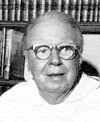 Clement Breen, the son of Solomon and Margaret O'Shea Breen, was bom in Chicago,
Illinois, on November 15,1904. He was baptized at Saint Andrew's Church on North
Paulina Street, on December 11, and confirmed at Holy Cross Church in the Spring of
1916.
Clement Breen, the son of Solomon and Margaret O'Shea Breen, was bom in Chicago,
Illinois, on November 15,1904. He was baptized at Saint Andrew's Church on North
Paulina Street, on December 11, and confirmed at Holy Cross Church in the Spring of
1916.
After the family moved to Minneapolis, Minnesota, Clement attended the Pro-Cathedral Grade School there and St. Thomas Academy in St. Paul, graduating in 1923. Anticipating a business career he studied economics and accounting at the University of Minnesota and began his college studies at St. Thomas College but transferred to Columbia (later Loras) College in Dubuque, Iowa. He was active in debate and drama as well as the college's publications, being elected later as editor of the Purgold, the college yearbook. After graduating, at age twenty-six, in 1931, Clement Breen applied to the novitiate of the Dominican Order. During his college years he had taken pre-seminary courses and had majored in philosophy, but he had not committed himself to a diocese. The college president recommended him to Father T.S. McDermott, the Dominican Provincial in New York, as "a young man of refined manners, of average talent and of excellent character and reputation."
Clement received the Dominican habit at St. Rose Priory in Springfield, Kentucky, on August 15, 1931, and the religious name, Brother Matthew. He made his simple profession one year later, August 16,1932, and proceeded with his class to begin studies in the houses of study in River Forest, Illinois; Somerset, Ohio; and Washington, D.C. He was ordained to the priesthood at St. Dominic's Church in Washington, D.C., on June 16, 1938, a member of the largest ordination class in the history of the Dominicans in the United States.
As a member of the newly established Midwestern Province, the Province of St. Albert the Great, Father Breen went to his first assignment at Blessed Sacrament Parish in Madison, Wisconsin, and the following year, as a mission preacher, he was assigned to St. Pius V Priory in Chicago. Continuing as a preacher in the western regions of the Province, he moved in 1943 to Holy Name Rectory in Kansas City. He then entered the Chaplain Corps of the United States Army. Following military service he returned to itinerant preaching in 1946, and was assigned to the "Southwestern Band" with headquarters at Holy Rosary Priory in Houston, Texas. In 1948, he changed to the "Northwestern Band" in association with the illustrious Father Vincent Ferrer Kienberger and Father David Balla, with assignment to Holy Rosary Priory in Minneapolis.
In 1951, Father Breen was appointed caput of the Northwestern Preaching Band. This assignment gave him the responsibility of "scouting" for invitations to preach parochial missions, novenas and Forty Hours devotions among the parishes and institutions of his territory; he was responsible for finding available preachers and assigning them to their missions, as well as continuing as a full-time preacher himself. This responsibility involved endless and tedious correspondence, coordinating schedules, adjusting to changes and contingencies, finding preachers for important invitations from pastors, bishops and religious superiors when there seemed to be too few preachers available. Throughout this work he was under constant pressure to serve as diplomat and public relations expert, both within the Dominican Province and in its relations with the Church of the Midwest. He was retained in this position, in various locales of the Province, for thirteen years. This testifies to his qualities of responsibility, reliability, tact and "refined good manners" that President Conry of Columbia College had pointed out in 1931.
In 1956 Father Breen moved from Minneapolis back to Chicago. Also in that year his talents and devotion to preaching, and the administration of the Province's preaching mission, were acknowledged by the Provincial Chapter: he was honored with the title and privileges of Preacher General. At that time this distinction gave him perpetual standing not only as an eminent preacher but as councillor in his Dominican community.
In 1964, when Father Gilbert Graham was elected Provincial, Father Breen stepped down from the duties of caput and continued full-time preaching from St. Anthony of Padua Priory in New Orleans, Louisiana. He was beginning to feel the wear and tear of the strenuous travel and ceaseless preaching and asked to be relieved. His request was honored in 1966 by Father Graham who wrote to him:
May I take this opportunity to express in my own name and for the Province our appreciation for the tremendous work You accomplished as a missionary and as Caput of the Mission Band for so many years. There is no Dominican in our Province who more faithfully and competently exemplified our preaching tradition throughout the Province for more than twenty-five years.In 1967, Father Breen returned to Madison, to Blessed Sacrament Parish, which had been his first assignment in 1939. His failing health should have entitled him to complete freedom from responsibilities but his own patience and determination won out, not only over the symptoms of disease, but overcame the greater challenges of doing nothing and consequent boredom. He adjusted to a very different style of life, cultivated a regular life of prayer and the celebration of the sacraments, a quiet but effective ministry to the Dominicans and parishioners at Blessed Sacrament. For over twenty years he became a mainstay of the Dominican community and won the affection and appreciation of the brothers who lived with him in the Priory and parishioners who counted on his prayerful presence in the church and sacristy.Your example both to the brethren and to priests and pastors wherever you worked was always as effective a sermon as those you gave from the pulpit.
In November of 1987, Father Breen moved to Nazareth House Nursing Center in Stoughton, Wisconsin, where even in illness he continued his ministry of preaching by the example of his life until his death on October 4, 1989. Following a funeral Mass at Blessed Sacrament Church in Madison on October 7, the feast of the Holy Rosary, he was buried in the Dominican plot at Calvary Cemetery in Madison, Wisconsin.
CHARLES CARSON FABIAN CHAMPLIN
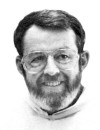 Charles Champlin was born on April 3,1935, in St. Paul, Minnesota, the older of the
two sons of Smith Lyman and Noreene Maria Kirey Champlin. His brother, Michael,
also became a Dominican priest. He completed elementary education at St. Columba
and Nativity Catholic Schools in St. Paul, from 1940 to 1948, and attended Cretin
Military Academy in St. Paul, graduating in 1953. In 1954 to 1955, he attended Loras
College in Dubuque, Iowa.
Charles Champlin was born on April 3,1935, in St. Paul, Minnesota, the older of the
two sons of Smith Lyman and Noreene Maria Kirey Champlin. His brother, Michael,
also became a Dominican priest. He completed elementary education at St. Columba
and Nativity Catholic Schools in St. Paul, from 1940 to 1948, and attended Cretin
Military Academy in St. Paul, graduating in 1953. In 1954 to 1955, he attended Loras
College in Dubuque, Iowa.
On August 30,1955 Charles Carson Champlin received the Dominican habit and his religious name of Fabian at St. Peter Martyr Priory and Novitiate in Winona, Minnesota. He made first profession there on August 31, 1956, then moved to the Dominican House of Studies, River Forest, Illinois, for his studies in philosophy, receiving a B.A. degree in 1959. He then moved to St Rose Priory in Dubuque, Iowa, to continue studies in theology. He was ordained to the priesthood on June 2,1962, by Archbishop James J. Byrne in the St. Rose Priory Chapel in Dubuque.
Father Champlin's first assignment was as associate pastor at Nativity Parish in Campti, Louisiana, during the summer of 1962. In October of that year, he moved to Malumfashi, Nigeria, where he served as associate pastor and instructor at the catechetical centre of St. Vincent Ferrer Church until 1972. During his first home leave, he attended the University of Minnesota and Duquesne University to study anthropology, and upon his return to Nigeria continued anthropological and ethnological research in northern Nigeria. He became proficient in the Hausa language and eventually served as translator for the Hausa Liturgical Commission.
On a home leave in 1970, Father Carson engaged in small-group retreat work with his brother, now Father Michael Champlin. Upon his return to the United States in 1972, the brothers became full-time preachers and joined the Dominican Evangelical Preaching Team based first in Denver, Colorado, and later in Oklahoma City, Oklahoma.
In 1977, he joined his brother to establish the Thomas More Center for Preaching and Prayer in the Diocese of Superior at Webster, Wisconsin, with assignment to Holy Rosary Priory in Minneapolis, Minnesota. The Center was formed for the purpose of providing a training program for those preparing for the ministry of preaching and an opportunity for renewal and continuing education for those actively engaged in preaching. During this time, they continued as full-time preachers and their ministry led them throughout the central and western United States as well as to Australia for frequent three-month periods spent in preaching spiritual renewal programs in parishes there.
In early 1987, Carson was diagnosed as having multiple myeloma, a rare form of cancer which attacks white blood cells found in the bone marrow. He underwent chemotherapy several times over the next years, was hospitalized at times, but during periods of remission continued in the preaching ministry. In spite of all efforts to alleviate his condition, Carson Champlin died on October 7, the feast of the Holy Rosary. Following the funeral Mass at Holy Rosary Priory in Minneapolis, Minnesota, on October 10, he was buried in the Dominican plot at Saint Mary's Cemetery in Minneapolis.
GERALD GILBERT DONALD SHERRY
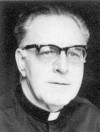 Gerald Gilbert Sherry, son of James Thomas and Mary Louise Brady Sherry, was born
in Putnam, Connecticut, on September 13, 1915, the third of six children (five brothers
and one sister). He grew up in Taunton, Massachusetts, where he attended St. Mary's
Grammar School, 1920 to 1929, and St. Mary's High School, 1929 to 1933. Following
a year of studies at Hamilton College in Clinton, New York, Gilbert Sherry transferred
to Providence College, Providence, Rhode Island, graduating in 1938 with an A.B. in
philosophy.
Gerald Gilbert Sherry, son of James Thomas and Mary Louise Brady Sherry, was born
in Putnam, Connecticut, on September 13, 1915, the third of six children (five brothers
and one sister). He grew up in Taunton, Massachusetts, where he attended St. Mary's
Grammar School, 1920 to 1929, and St. Mary's High School, 1929 to 1933. Following
a year of studies at Hamilton College in Clinton, New York, Gilbert Sherry transferred
to Providence College, Providence, Rhode Island, graduating in 1938 with an A.B. in
philosophy.
On September 11, 1938, he entered the Dominican Order at St. Rose Priory in Springfield, Kentucky, receiving the habit and the religious name of Donald, and made his first profession there on September 12, 1939. Philosophical and theological studies followed at the Dominican House of Studies in River Forest, Illinois, with the granting of the S.T.Lr. degree in 1942 and the Ph.D. in philosophy in 1946. On March 23,1945, he was ordained to the priesthood at the Dominican House of Studies Chapel by the Most Reverend William D. O'Brien, Auxiliary Bishop of Chicago.
Father Sherry's first assignment was as professor of philosophy at De Paul University, Chicago, Illinois, where he taught from 1946 to 1956. In 1956, he was elected prior at St. Pius V Priory in Chicago, Illinois, and subsequently appointed pastor of St. Pius V Parish there, in which offices he served until 1962. He was then appointed superior and pastor of St. Vincent Ferrer Parish in River Forest, Illinois. In 1964, he was elected first prior by the St. Vincent Ferrer Dominican community and served there until 1970. During this time, he continued teaching on a part-time basis, offering courses in ethics to the nurses at St. Anthony's, Mercy, and Little Company of Mary Hospitals.
During 1970, which Father Sherry had scheduled for a sabbatical, his father had a stroke, and he asked that his next ministry be in the East so that he might assist his aging parents. Permission was granted, and from late 1970 to 1975, he served as professor of philosophy and religious studies at Mount Saint Joseph College, and offered pastoral assistance at St. Raymond's Dominican Parish in Pawtucket, Rhode Island, where his parents lived.
Even while caring for his parents, his own health began to deteriorate, requiring surgery for several ruptured and fused spinal discs and to alleviate pressure on his spinal column. In addition to his physical disability, Mount St. Joseph College closed, thus limiting his ministry to parish work. After his parents' deaths in the late 1970's, his own health problems continued, including an operation for cancer, followed by chemotherapy treatments. For the next several years he remained in the East, assisting with pastoral ministry at St. Barnabas Church in Portsmouth, Rhode Island, on a limited basis. In 1988, he returned to Pawtucket where he lived with his brother, Roger or, when ill health demanded, in a nursing home. In late 1989, following visits and encouragement by the Provincial and Socius, he indicated his wish to return to the Province and thus moved to the Priory of St. Dominic and St. Thomas in River Forest, Illinois. His health continued to deteriorate, requiring hospitalization shortly before his death on June 4, 1990.
On Thursday, June 7, many of his Dominican brothers who had gathered for a Provincial Assembly preceding the Thirteenth Provincial Chapter of the Province of St. Albert the Great, concelebrated the Mass of the Resurrection for him at St. Vincent Ferrer Church in River Forest, Illinois. He was then moved to St. Barnabas Church in Portsmouth, Rhode Island, where a funeral Mass was celebrated on Saturday, June 9, 1990. Burial followed in the family plot at Gate of Heaven Cemetery in East Providence, Rhode Island.
RICHARD RAYMOND FRANCIS SHAW
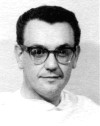 Richard Raymond Shaw, son of Raymond Leo Shaw and Viola Elizabeth Karafiat, was
born at St. Anthony's Hospital in Chicago, Illinois, on June 6, 1931, and baptized a
month later at Saints Cyril and Methodius Church on South Hermitage Avenue. He
grew up in Cicero, Illinois, where he attended St. Frances of RomeSchool until 1941
when his family moved to Elmwood Park, Illinois, and completed his elementary
education at St. Vincent Ferrer School in River Forest. He graduated with honors from
Fenwick High School in Oak Park, Illinois, in 1949, and then pursued college studies
at De Paul University in Chicago. His close association with Dominican priestsand
brothersand Sinsinawa Dominican Sisters in River Forest and Oak Park encouraged
him to enter the Dominican Novitiate at St. Peter Martyr Priory in Winona, Minnesota,
where he was assigned Francis as a religious name and later made his first profession
on August 31, 1952.
Richard Raymond Shaw, son of Raymond Leo Shaw and Viola Elizabeth Karafiat, was
born at St. Anthony's Hospital in Chicago, Illinois, on June 6, 1931, and baptized a
month later at Saints Cyril and Methodius Church on South Hermitage Avenue. He
grew up in Cicero, Illinois, where he attended St. Frances of RomeSchool until 1941
when his family moved to Elmwood Park, Illinois, and completed his elementary
education at St. Vincent Ferrer School in River Forest. He graduated with honors from
Fenwick High School in Oak Park, Illinois, in 1949, and then pursued college studies
at De Paul University in Chicago. His close association with Dominican priestsand
brothersand Sinsinawa Dominican Sisters in River Forest and Oak Park encouraged
him to enter the Dominican Novitiate at St. Peter Martyr Priory in Winona, Minnesota,
where he was assigned Francis as a religious name and later made his first profession
on August 31, 1952.
Philosophical studies followed at the Dominican House of Studies in River Forest, Illinois, until 1955 when Brother Francis was sent to the College of St. Albert in Oakland, California, to begin theological studies along with a number of student brothers from St. Albert's Province assigned to studies in Holy Name Province at a time when the studia in River Forest and Dubuque were seriously overcrowded. On June 14, 1956, he was ordained a deacon at St. Patrick's Seminary Chapel in Menlo Park, California. In September, 1956, the new Priory of St. Rose was formally opened in Dubuque, Iowa, and Francis with several of his confreres were called back by the Provincial, Father John Marr, to finish their theological courses in the Central Province studium. On May 24, 1958, Francis was ordained a priest in St. Rose Priory Chapel in Dubuque by the Most Reverend Edward Celestine Daly, O.P., Dominican Bishop of Des Moines, Iowa. On the following day, Pentecost Sunday, he celebrated his First Solemn Mass at his home parish of St. Vincent Ferrer in River Forest.
Father Shaw's first assignment was to Albuquerque, New Mexico, to the staff of Aquinas Newman Center and to the faculty of St. Joseph College on the Rio Grande (later renamed the University of Albuquerque; the school ceased operations in 1988). In the fall of 1959, he was sent to St. Pius V Priory in Chicago for a special assignment to teach at Saint Xavier College in Chicago and to help develop instructional materials for the theology and literature component of the Xavier Plan of Liberal Education, a collaborative project designed by Dominicans of the Albertus Magnus Lyceum and the Chicago Province of the Sisters of Mercy. In September of 1964, Father Shaw was assigned to serve as superior at the newly established St. Dominic's House (Euclid Avenue) on Chicago's South Side and was appointed associate professor of English and theology and chairman of the Theology Department at St. Xavier College. He also wrote a weekly column, "Here's the Answer," for The New World, Chicago's Archdiocesan newspaper.
At the end of the spring semester of 1967, he was approved to pursue doctoral studies in theology and literature at Fordham University in New York, but those plans were changed abruptly on May 12,1967, when he was elected Prior of St. Thomas Priory in River Forest, Illinois, the Dominican community of Aquinas Institute of Philosophy. In addition to serving as Prior, Father Shaw continued conducting a liturgy seminar at St. Xavier College, teaching courses in liturgy and in literary theory at Aquinas Institute, and offering introductory courses in liturgy and spirituality for the Alexian Brothers' novices and postulants at Alexian Brothers' Hospital in Chicago. The late 1960's presented special difficulties for anyone responsible for seminary training and religious formation. Father Shaw and the religious and academic administrators of the Province tried to meet these new challenges by establishing a formation team and by attempting to develop a more coordainated training program between the novitiate and houses of philosophy and theology that allowed more flexibility in accommodating canonical requirements with post-conciliar directives on religious life.
In the early fall of 1968, Father Shaw and the Dominican community at Aquinas Institute of Philosophy hosted the General Chapter of the Dominican Order that devoted two months of intense work to produce a complete revision of the Book of Constitutions and Ordinations for the Order based upon the norms of the Second Vatican Council. In late May of 1969, the River Forest community hosted the Eighth Provincial Chapter of St. Albert the Great Province that took six weeks to draw up all the particular legislation required by the Order's newly revised Constitutions. This Chapter named Father Shaw Director of the newly formed Provincial Formation Team.
In 1972, Aquinas Institute of Philosophy was merged with the faculty of Theology in Dubuque, Iowa. Father Shaw then joined the Provincial Staff as Secretary of the Province and moved to St. Albert the Great Provincial House located on Bennett Avenue in Chicago's Jackson Highlands neighborhood. Then on November 20,1973, he was elected Prior of St. Pius V Priory in Chicago. He continued as Prior until he was named Socius and Vicar Provincial in 1976. After completing his terrn in Provincial administration in 1983, Father Shaw took a semester of sabbatical studies at Aquinas Institute of Theology in St. Louis, Missouri, before returning to St. Pius V Priory in Chicago for a six-month project that produced a new translation of the Liber Constitutionum et Ordinationum for use in all the English-speaking Provinces and Vicariates of the Order.
In February, 1985, Father Shaw joined the staff of the Metropolitan Tribunal of the Archdiocese of Chicago and also began part-time service in the Chancery Office of the Archdiocesee. In December of 1986, he was named full-time Assistant Chancellor of the Archdiocese by Joseph Cardinal Bernardin. During this time, Father Shaw had been given permission by his Prior and his Provincial to care for his mother who was suffering a series of debilitating illnesses that led ultimaterly to her death on December 10, 1986. On October 19, 1987, Father Shaw moved to Saint Vincent Ferrer Priory in River Forest where he could care for his mother's only sister, Mary Karafiat, who died on December 11, 1989. While concentrating his efforts on aiding her convalescence, Father Shaw developed a digestive disorder that medical tests revealed to be a rare type of malignant duodenal tumor. Surgery at Loyola Medical Center in Maywood, Illinois, proved ineffective since smaller cancerous growths not detected by earlier testing procedures were discovered scattered throughout his lower abdomen. Father Shaw continued to carry out his responsibilities to his family, his religious community, and the Archdiocese of Chicago for as long as he retained sufficient strength. Francis Shaw died peacefully at 12:25 p.m. on June 14, 1990, in Loyola Medical Center, Maywood, Illinois. Mass of the Resurrection was celebrated on June 18 at St. Vincent Ferrer Church in River Forest with Father Donald Goergen, Prior Provincial, presiding. Father Benjamin Russell preached the homily, and his Eminence, Joseph Cardinal Bemardin, Archbishop of Chicago, present in the sanctuary, led the final commendation. Most of the Vocals of the Thirteenth Provincial Chapter, which was taking place at the time of his death, were present to bid "Franny" a fond farewell. He was buried with his Dominican Brothers in the community plot at All Saints Cemetery in Des Plaines, Illinois.